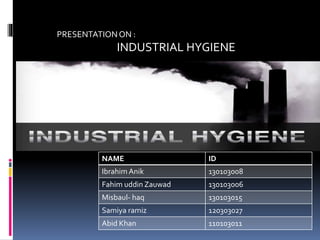
Industrial Hygiene Presentation
- 1. PRESENTATIONON : INDUSTRIAL HYGIENE NAME ID Ibrahim Anik 130103008 Fahim uddin Zauwad 130103006 Misbaul- haq 130103015 Samiya ramiz 120303027 Abid Khan 110103011
- 2. INDUSTRIAL HYGIENE Industrial hygiene is the science of anticipating, recognizing, evaluating, and controlling workplace conditions that may cause workers' injury or illness. Industrial hygienists use environmental monitoring and analytical methods to detect the extent of worker exposure and employ engineering, work practice controls, and other methods to control potential health hazards.
- 4. Cause of INDUSTRIAL HYGIENE Sickness Impaired Health andWellbeing Significant Discomfort In-efficiency among workers or among citizens of community
- 5. Relation Between OSHA and Industrial Hygiene Under the Act, OSHA develops and sets mandatory occupational safety and health requirements applicable to the more than 6 million workplaces in the U.S. OSHA relies on, among many others, industrial hygienists to evaluate jobs for potential health hazards.
- 6. Some Examples of Job Hazards To be effective in recognizing and evaluating on-the-job hazards and recommending controls, industrial hygienists must be familiar with the hazards' characteristics. Major job risks can include air contaminants, and chemical, biological, physical, and ergonomic hazards.
- 8. Chemical Hazards Harmful chemical compounds in the form of solids, liquids, gases, mists, dusts, fumes, and vapors .Some are toxic through inhalation and some of them irritate the skin on contact; some can be toxic by absorption through the skin or through ingestion, and some are corrosive to living tissue.
- 9. Physical Hazards These include excessive levels of noise, vibration, temperature etc. In occupations where there is exposure to ionizing radiation, time, distance, and shielding are important tools in ensuring worker safety. Danger from radiation increases with the amount of time one is exposed to it; hence, the shorter the time of exposure the smaller the radiation danger.
- 10. Biological Hazards These include bacteria, viruses, fungi, and other living organisms that can cause acute and chronic infections by entering the body either directly or through breaks in the skin. Occupations that deal with plants or animals or their products or with food and food processing may expose workers to biological hazards. Laboratory and medical personnel also can be exposed to biological hazards.
- 12. TOXICITY HAZARD Inhalation -Vapor ,mist or dust Absorption - Skin or eyes Oral - Ingestion Carcinogenic
- 14. MECHANICAL HAZARDS Over pressurization System leak Rotating/moving equipment's Thermal burns Noise generation Equipment/utility failure
- 16. How do IH's Recognize and Control Hazards? Industrial hygienists recognize that engineering, work practice, and administrative controls are the primary means of reducing employee exposure to occupational hazards. Engineering controls minimize employee exposure by either reducing or removing the hazard at the source or isolating the worker from the hazards.
- 17. Steps to Protect Employees Anticipate potential hazards Recognize potential hazards Evaluate exposure and risk Control exposure and risk
- 20. Symbols
- 21. Symbols
- 23. Thanks to all of you in your kind anticipation
